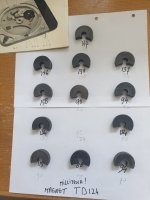Shaded pole induction motors are not fully synchronous which means changing the mechanical load or line voltage with affect the motor speed. I no longer remember the exact numbers but I think somewhere between 1700 - 1740 rpm is in range for 60Hz operation.
Measure the ID of your cast iron platter and the Swissonor, if they are not the same there is part of your problem. Note that cast iron platters all have 50/60Hz strobes for 33, 45 and 78 and as memory serves the 16 rpm shares the 33 rpm strobe. The zamac platters found mostly on MKII have only 33 rpm strobe markings for 50 and 60Hz IIRC. (I threw mine away and replaced with cast iron platter)
These days I mostly use my Scheu Premier II to listen to vinyl so the 124 gets little attention. I am down to something like 10 - 20 hours a year of vinyl playback, the rest is digital (streamed via Roon).
Measure the ID of your cast iron platter and the Swissonor, if they are not the same there is part of your problem. Note that cast iron platters all have 50/60Hz strobes for 33, 45 and 78 and as memory serves the 16 rpm shares the 33 rpm strobe. The zamac platters found mostly on MKII have only 33 rpm strobe markings for 50 and 60Hz IIRC. (I threw mine away and replaced with cast iron platter)
These days I mostly use my Scheu Premier II to listen to vinyl so the 124 gets little attention. I am down to something like 10 - 20 hours a year of vinyl playback, the rest is digital (streamed via Roon).
Do you have a laser tachometer so you can measure the motor speed without belt ?Thank you for the detailed reply, it's a nice list of areas to probe further.
The magnet seems strong but not sure how to measure the strength and the acceptable range. Have seen used ones for sale on eBay considering. The pulley seems to be oriented correctly (larger diameter on top from the pic I took).
Would like to think that the Swiss outfit that did the restoration and upgrade would be amongst the top places to do such work on Thorens and so most of the boxes should be checked but will find out... The main visible change is a new bronze bushing replacing the plastic bushing used in the bearing for early model TD-124's and new/upgraded motor suspension and springs. The motor and chassis were are also restored. Had a similar rpm issue before the restoration work.
Lowering the voltage is a shortcut to solving the problem. High power winding adjustable resistors or autotransformers can be used.Hello All,
I am new to diyAudio and glad to find this informative thread!
Have been looking into slowing down the rpm of my Thorens TD-124 which is off by ~3% (34.2rpm) when set to minimum fine speed control (knob fully CCW). The magnet is as close to the stepped pulley as possible also. This unit is a very early model and after my initial work on it to make functional, been professionally restored and upgraded so a bit disappointed that there is still an rpm issue.
My question is: has there been any successful experience with slowing down the rpm using a stronger magnet (or even doubling up the magnet, though this may need a longer screw)? Any other angles I should be looking at?
All thought on this or related welcome!
Thank you,
Henry
Here are some measurements on the brake magnet there is a clear difference in strength as you can see,but before take any conclusions we first need to know the unloaded speed from the motor and the mains supply , assuming you use the 110-120 v setting. Since your motor is revised in Swiss they probably used solid bronze motor bushings these have little friction is my experience so the speed is high .
Also testing the conditions of this motor in Europe can give different results.
Also testing the conditions of this motor in Europe can give different results.

Thank you, very useful info (bronze bushing=> higher speed) and picture on variations of magnetic field for the brake magnets! Certainly two more factors to take into account.
As an update: I tested the AC line voltage last week and was surprised to see it arrive at 123.5V, considerably higher than I expected!! It certainly explains the difficulty with obtaining correct rpm with 100-120V setting. This (123.5V) seems to be an unaccommodating voltage given it sits in between the upper end of lowest range (100-120V) and the lower end of the middle voltage range (125-150V). Hoping w/ some luck the second setting with max CW fine speed control might work but need to experiment...
My efforts to experiment with the turntable have been slowed down now that the turntable is at its new owner location (a family member). It will be another couple of weeks before more trials.
Meanwhile, any experiences with voltages between 120V and 125V and ability to obtain an exact rpm of 33.0 would be helpful.
As an update: I tested the AC line voltage last week and was surprised to see it arrive at 123.5V, considerably higher than I expected!! It certainly explains the difficulty with obtaining correct rpm with 100-120V setting. This (123.5V) seems to be an unaccommodating voltage given it sits in between the upper end of lowest range (100-120V) and the lower end of the middle voltage range (125-150V). Hoping w/ some luck the second setting with max CW fine speed control might work but need to experiment...
My efforts to experiment with the turntable have been slowed down now that the turntable is at its new owner location (a family member). It will be another couple of weeks before more trials.
Meanwhile, any experiences with voltages between 120V and 125V and ability to obtain an exact rpm of 33.0 would be helpful.